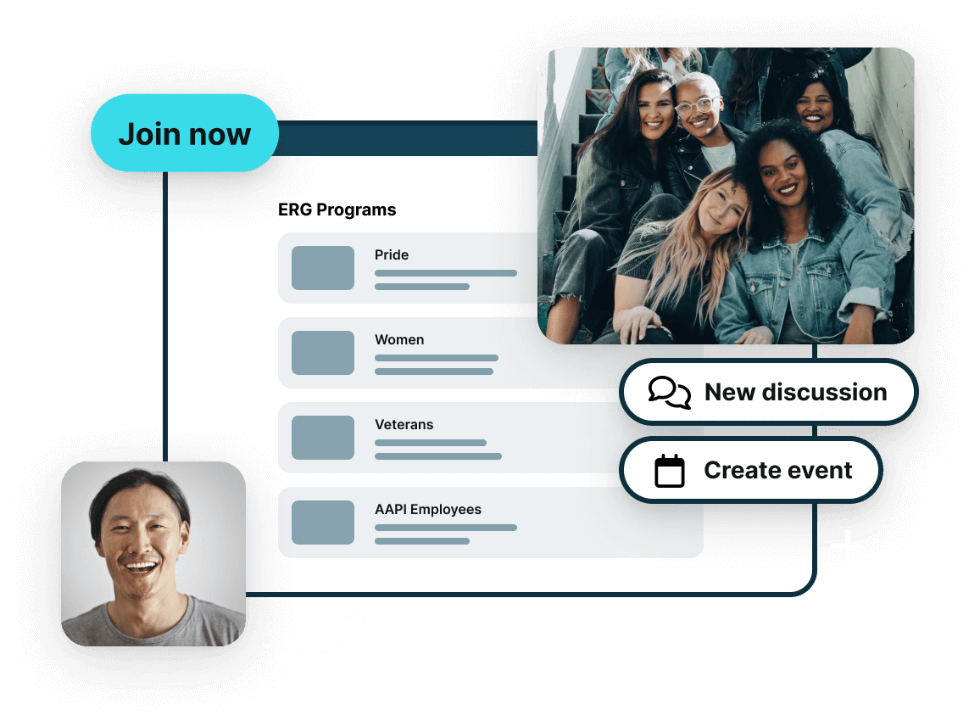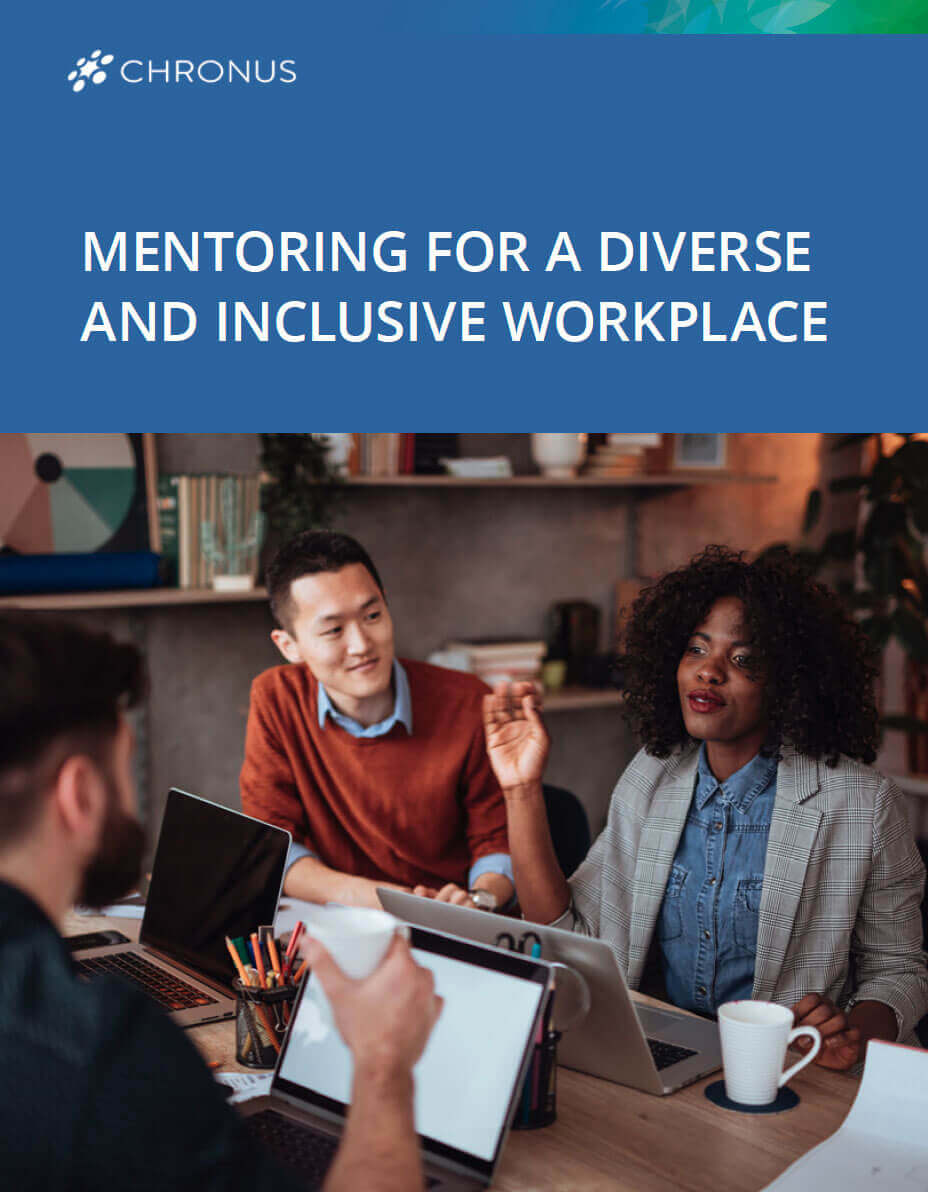How to Promote DEI in the Workplace

What is DEI in the workplace?
When it comes to Diversity, Equity and Inclusion (DEI) in the workplace, the research is clear. Diverse companies outperform their less-diverse counterparts in terms of profitability. Organizations that work to create a company culture where workers from all backgrounds can thrive are able to attract a wide pool of talent and are in a strong position to attract a diverse customer and client base as well.
DEI—while often mentioned as an umbrella concept—actually covers three different (but closely related) issues. Here’s an in-depth look at each acronym within DEI and their collective impact on workplace environments.
Diversity in the workplace
Diversity refers to the demographic makeup of the organization. Many organizations see diversity through the lens of race and gender, but it can also refer to age, disability status, sexual orientation and educational status.
Equity in the workplace
Equity, as defined by research firm Gallup, concerns “fair treatment, access, and advancement for each person.” An organization might be diverse in nature but have policies that favor one group over another. For example, a company without a robust parental leave policy or flexible work arrangement might unfairly punish working parents who are the primary caregivers in their families.
Inclusion in the workplace
Inclusion often refers to a company’s culture. An inclusive culture is one where every employee feels supported, accepted and valued as they are. An inclusive organization allows all employees participate in decision-making processes and development opportunities at every level of the organization.
In this Article:
Why Should Companies Focus on DEI in the Workplace?
Promoting diversity, equity and inclusion (DEI) in the workplace is crucial for fostering innovation and organizational success. When companies embrace diverse perspectives, experiences and backgrounds it leads to the enrichment of decision-making processes while also cultivating a culture of respect, empathy and understanding from the top of the leadership chain on down.
Business Return on Investment (ROI)
The importance of DEI on Business Return on Investment (ROI) is shown through the statistics listed below. Businesses and those in pivotal leadership positions must take heed of the statistics that underscore the tangible benefits of prioritizing DEI initiatives in the workplace.
As demonstrated by these figures, when companies fully embrace DEI initiatives it can lead to a more equitable environment and drive significant business outcomes.
The numbers speak for themselves:
- Diverse companies enjoy 2.3x higher cash flow per employeeli>
- Diverse management boosts revenue by 19 percent
- Racially and ethnically diverse companies are 35 percent more likely to outperform their industry peers
- Belonging can lead to a 56% increase in job performance, a 50% reduction in turnover risk, a 167% increase in employer net promoter score
Employee Wellbeing
There’s an impact on morale as well. Employees are 2.4x more likely to say they’re proud to work for a company that fosters an inclusive culture. One Qualtrics article notes that “when we feel we belong somewhere, we feel cared about. We can relax, breathe, express ourselves and be ourselves. We feel enough psychological safety to do things and put ideas out there, knowing we won’t be judged and rejected.” There’s proof and recognition that DEI is not a nice to have, but a need to have.
Corporate Social Responsibility (CSR)
DEI is a mainstream business standard that is impossible to ignore. Avoidance or indifference is a business risk. The emergence of social media has brought more transparency, risk of exposure and demand for accountability than ever before as it shines a spotlight on systemic inequity, discrimination, toxic company culture and failures in leadership.
Social activism at work is at an all-time high due to a combination of outside influences and issues created and perpetuated by employers themselves. Businesses aren’t just fighting for market share or growth anymore, but mere survival. It’s critical to have and optimize the best talent to compete in both good and bad economies.
So while the data, acknowledgment and business needs may be there, progress is slow and impact is anemic when it comes to DEI. Gaps remain in advancing DEI as a whole. Whether it’s a failure to get the basics right, lack of a strategy, resistance to change or inconsistency, the result is that conditions are not in place for diversity to thrive in many companies.
It doesn’t have to be this way. Organizations are uniquely positioned to address these issues. They have a common purpose, shared values and culture, more resources and the discretion to use them.
The Guidelines for Building Your Own DEI Strategy
The challenge for every organization is to determine how they themselves will address DEI. To ensure meaningful progress, it has to be:
More than the minimum. Cursory efforts lack meaning and appear inauthentic. It sets up an expectation of accountability where there is none. Getting the basics right, such as defining what DEI means for your company, establishing goals, recruiting for diverse talent, developing DEI capability, building trust, and following through are non-negotiables, but still not enough. These are the norms, not exceptions. According to Deloitte, creating a belonging culture of comfort, connection and contribution impacts how employees shows up, be themselves and contribute to an organizations’ common goals. These are the norms, not exceptions.
Strategic. DEI as simply an initiative can be short-lived. Reframing DEI as a strategy is one of the keys to sustainability. All DEI work should serve the same purpose as well as be connected, integrated, and mutually reinforcing. Efforts have to be dedicated, intentional, and focused while also being built into the way a company does business.
Differentiated. Copying best practices in their entirety and without consideration of the context yields mixed results. Doing what everyone else is doing is also antithetical to the meaning of diversity. If the aim is to compete for the best talent, then an organization must show how they’re uniquely positioned to better serve underrepresented employees. Avoid the “one size fits all” approach and customize your strategies to your organization and its people.
Scalable and consistent. DEI is not an end state. It requires continuous improvement and maintenance to cultivate and sustain it. After all, the conditions for DEI must be there all of the time, not some of the time. It has to be embedded in all parts of the company and grow with it. Consistency demonstrates commitment. Inconsistency erodes trust.
A positive impact. Most will recognize that DEI doesn’t happen overnight. It won’t even happen in a quarter. However, if day-to-day experiences stay the same and people don’t see positive change along the way, they lose faith. Showing progress and being transparent about your efforts (success and failures) builds trust in a company’s commitment to DEI.
The Connection to DEI and Workplace Culture
Many organizations don’t know where to start when it comes to building a DEI strategy. The way I frame it when working with organizations as part of my consultancy, Co.-Design of Work Experience, is as follows:
“Culture communicates the boundaries of what is acceptable and not acceptable and manifests itself in how people behave, interact, react, and perceive reality. Culture is created, reinforced and experienced by people. It includes not just what’s said, but what’s lived. Simply put, culture is made up of what’s acceptable, unacceptable or condoned.”
Therein, a lack of diversity is also a company culture problem. You can’t address DEI without addressing the culture because it influences every aspect of how a company operates. It’s what sets or erodes the conditions for diversity to succeed.
By aligning the company’s DEI strategy with employee experience and workplace culture, the potential for success is much higher. What needs to be done is known or can be discovered. What remains—and where many companies fall short—is execution. Crises (such as the one brought on by the Covid-19 pandemic) have exposed and even exacerbated systemic inequalities. An economic downturn puts a company’s commitment to DEI to the test as they consider where to cut budgets. But beware, those with short-term mindsets will choose to sacrifice long-term gains in exchange for long-term problems.
– Karen Jaw-Madson, author and Principal at Co.- Design of Work Experience
Get the eBook Now
Download the Free eBook to Take on the Go

Examples of DEI Programs and Initiatives
DEI initiatives and programs can take many forms. Below are some common practices that organizations have successfully employed to improve DEI.
Mentoring
Mentoring can be an effective way to bolster DEI, particularly when it comes to retaining diverse talent. A Heidrick & Struggles survey found that 74% of minority respondents said that a formal mentoring program can help them accelerate their careers and achieve professional growth. . When employees have professional development opportunities at their place of work, they’re more likely to be loyal and engaged. In turn, they’ll be more likely to promote the company to their peers and provide another avenue of diverse talent pool that the organization can tap into.
Below are the different forms of mentorship programs that companies might want to consider implementing:
- Career Mentoring. This is a one-on-one arrangement where senior leaders are paired up with junior employees to share their knowledge and expertise.
- Mentoring Circles. This is where a group of employees regularly meet to discuss a topic or issue of their choosing to share their experiences and brainstorm potential solutions together. Mentoring circles can also act as a safe space for minority employees to share their concerns in the organization.
- Reverse Mentoring. Unlike traditional mentoring, reverse mentoring means early-level employees act as a mentors to senior employees. This works very well when it comes to issues, practices and emerging trends that may be more intuitive to younger employees.
- Buddy Programs. High-performing employees are paired to support newer employees when they first join the company. The purpose is to integrate them into the organization and help them build their confidence.
Setting up a DEI mentoring program can enable build greater connections, networks and opportunities for underrepresented employees.
ERGs
Employee Resource Groups (ERGs) can be particularly beneficial to improving inclusion. Like mentoring circles, they can form a support network and a safe space for employees who share a similar identity or issue to share their experiences with each other.
ERGs can also advance a company’s DEI strategy by boosting visibility among under-represented groups within the organization, as well as promoting external impact through volunteer and charity activities. McKinsey research shows that employees who rated their ERGs as effective were “much more likely” to report feeling included at work than those who gave their ERGs ineffective or very ineffective ratings.
Recruitment and Hiring Practices
Organizations also need to pay attention to their inclusive recruitment and hiring practices if they want a diverse pool of candidates. That means ensuring that their job descriptions are inclusive and free of gendered language (words like ‘rockstar’, for example, can potentially alienate female applicants) and tapping into talent channels that they haven’t explored before. If a company traditionally hires from the same colleges, it may be worth considering other schools to hire from. At the senior level, they may want to consider building relationships with professional association groups and communities.
Three Ways to Promote DEI in the Workplace
A company will only achieve its DEI goals if its employees are also invested in creating a diverse, inclusive and equitable workplace. Below are some of the ways that they can promote DEI within the organization:
- Ensure leadership buy-in. Leading by example can go a long way in improving DEI. If an employee sees their manager actively working towards building an inclusive workplace, they’re likely to do the same when they become managers.
- Create a culture of openness and continuous learning. Transforming a company culture and demographic will not be an overnight endeavor. And in the process, there will be growing pains and errors. Companies need to allow for this and provide an environment where people aren’t punished for trying and making mistakes.
- Implement inclusive policies and benefits. At a structural level, companies need to make sure that their benefits policies aren’t geared to provide advantages to certain groups and disadvantages to others. This may look like extending medical coverage to domestic partners, providing a gender-neutral parental leave policy and ensuring that employees have the option to take PTO for religious holidays.
Conclusion
Human connection has become critical in the past few years as workers seek to balance productivity and engagement with the responsibilities and concerns of their lives outside the workplace. Whether working remote or in a physical workplace, all employees need to feel safe and secure bringing their full selves to work. But in order to build and sustain a culture of belonging where all employees have equitable opportunities to thrive, organizations can’t rely on leaving things to chance.
In order to see real change, organizations must invest in holistic solutions rather than check the box fixes. Mentoring establishes measures of accountability, fosters a truly inclusive workplace and can exist across all stages of your employee experience. This powerful approach can move the needle in creating a more diverse, equitable and inclusive workplace.


